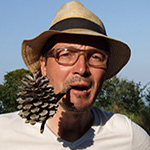Interactive sound installation in two parts.
In cooperation with the Orchestra of Change of the Staatskapelle Berlin.
 PERCEPTION
PERCEPTION
The 'Listening Green' sound installation plays with our acoustic perception of landscape. Interactive 'sound trees' surprise visitors crossing the 'Tälchenbrücke' (bridge) with unexpected tone sequences. At the end of the bridge, people can then actively listen to the green space using the 'sound telescope'.
 NEOBIOTA
NEOBIOTA
The installation deals with the way we deal with alien species in the nature, the so-called neobiota - invasive species. In this way, six exotic bird voices emerge from the six auditoriums, imitated by the instrumentalists of the state opera, who are played in 12 bird duets.
And in the sound telescope, the migratory stories of native and non-local animals, which are visually mirrored in the real picture, can be heard in a wagnerian natural mood. A similar question arises as in the social debate about the immigration society: Who is allowed to live here? And who determines it?
 UTOPIA
UTOPIA
In contrast to this, an old paradise fantasy appears, which appears in the sound telescope in four utopian-blue patches in the landscape: 'The Golden Age' from the metamorphoses of Ovid - spoken by Angela Winkler in the style of a reading test. A text which speaks in almost revolutionary terms of a way of life in which people are in harmony in their relationship to themselves and to nature - "unconstrained, without avenger, without law".
sound trees
sound telescope
Baltimore Trupial Ring-necked Parakeet Common Myna Golden Oriole Kookaburra+Pitohui Japanese Paradise Flycatcher Catbird Orpheus-Wren Lowland-Graupiha Benguela-Lark Northern Cardinal Mockingbird
Golden Oriole Ruddy Shelduck Hornbeam Rhea americana Mammoth Tree Fox Turkey Oak Collared Dove Ring-necked Parakeet Racoon Chinese Mitten Crab Deer

Matthias Rebstock: You have dealt with the issue of boundaries in a whole series of works. In the European Border Watch project, you confront the recipients with their personal relationship to the "protection" of the European external border. In Speak' with me, you point to a normally secret boundary in the center of Brunswick, which delimits the prostitution area from "normal" public space. And in TRASA, you enable passers-by to cross the geographical border or separation between Warsaw and Berlin through an encounter in a video circuit, which is, however, alienated in a special way. Does your new work GRÜN HÖREN / LISTENING GREEN, which you have set up for the IGA in Marzahn, also address this topic?
Georg Klein: Yes, you could see that. LISTENING GREEN consists of two parts: six loudspeakers hidden in the trees and a sound telescope. In the "Hörbäume" (sound trees) I work with birds' voices of so-called non-native species and let them compete with the domestic birds. What is interesting for me is the discussion on the question: What is classified as a non-resident and what is not. So what is an invasive species, a species that does not belong here, and who determines that - what is also a mirror for our human society, where we lead the same disputes.
M.R.: That is, the discussion about invasive species follows similar patterns to the discussion about human migration?
G.K: Exactly. For example, it is always a matter of the perceived threat that the native species are becoming less and subdued. And for this there are actually corresponding examples from the plant kingdom as well as from the animal kingdom. But quite often it is only panic, because in many species it is not clear whether it has any negative effects. For example, the racoon is not rescreened if he does more harm than the fox. Interestingly, I found in my employment that Central and Northern Europe, because of the ice age, has so many species destroyed. Actually many alien species could still come - and it would be an enrichment. And, in principle, everything we call indigenous is, at some point, immigrated.
M.R.: How does the audience learn about this subject? I hear birds' voices, but I do not generally recognize the native ones and which bird voices are alien.
G.K.: There are some bird voices like the Orpheus Wren. This bird can make extremely atonal tone sequences - incredible whistles. This is one of the birds you would say: I have never heard him before, it sounds alien. If you cross the "Tälchenbrücke", you hear it and you come through a second light barrier and a musical form of this bird voice emerges. There is a second "alienation", a form of a cultural appropriation of the natural in art, first in an imitation by an instrument, then further in a 6-channel, electronic swarm formation.
But just by these alienations, of course, the subject is not yet clear. Therefore the work has a second part: When you have crossed the bridge, you arrive at the sound telescope. This is a kind of telescope as they stand on viewpoints, only with an acoustic dimension, with two speakers like a headphone. When you look through the telescope and focus on specific sections, short texts appear: stories about the migration of invasive and domestic species and how we deal with them.
M.R.: LISTENING GREEN is thus also a work that deals with borders, border violations and border crossings. Can you briefly outline what the fascination with the issue of border makes for you?
G.K.: It is so that one is occupied with different things and only in hindsight notices that it is always about the issue of borders*. But my perspective is not so much about crossing the boundaries. I find it more interesting to stand on the frontier and move on the frontier than to say: I am breaking the border. This is also such a common topos in the art: crossing boundaries, the boundaries between the media and the genres and so on. That interests me little, but rather, to stay in an ambivalent situation and to look at both sides. So even in an intermediate area, from where it is unclear where it could go. I like to introduce people into such an area of irritation. Irritation is a very decisive word for my work because I think that through it something is triggered in the head: to question and seek oneself. This search is also important to me: I like to build situations in which people can gradually make their discoveries.
The permanent sound art project 'Listening Green' is the result of a competition organised by Grün Berlin GmbH, IGA Berlin GmbH, and the Orchestra of Change, founded by musicians of the Staatskapelle Berlin. Its realisation is being funded with the support of the Groth Gruppe.
Special project of the IGA art exhibition "Sichten einer Landschaft / Views of a Landscape", ZKR (Curator: Katja Assmann).
Opening concert with the Orchestra of Change / Staatskapelle Berlin, conductor Daniel Barenboim, at June 18th 2017.
Idea/Concept/Realisation: Georg Klein
Voices: Angela Winkler, Johannes Wilms
Instruments: Markus Bruggaier (Horn), Matthias Glander (Clarinet)
Simone Bodoky - van der Velde (Flute), Fabian Schäfer (Oboe) - Staatskapelle Berlin
Texts: 'The golden Age' (Ovid, Metamorphoses), Migration / Invasive species (Georg Klein)
Musik: 12 bird duets (Georg Klein), Natural moods of german, romantic operas (Weber / Wagner - Staatskapelle Berlin), Bird recordings: xeno-canto.org
Programming/Sensoring: Georg Klein, Pascal Staudt
Graphic/SoundTelescope: Steffi Weismann
SoundTelescope/3D/Construction: Viscope (idee concept), Daniel Vogel-Essex (Ozon), Arne Clemens (interzone)
Instrumental recordings: Johannes Seibt (State Opera Berlin)
The didactic programs were specially developed for the installation and they use the installation with an iPad control as an instrument and a spatial reproduction station in the park.
Natur klingt gut
for children from 7-10 years (Kathrin Scheurich / StadtNatur)
Franky frägt dich
for children from 11-15 years (Laura Holke with Rob Brinkmann / State Opera Berlin)
> workshops video documentation
 |
 |
 |
Gärten der Welt Berlin / GRÜN Berlin GmbH
Eisenacher Straße 99
12685 Berlin
 U5 Kienberg / Gärten der Welt / Berlin-Marzahn
U5 Kienberg / Gärten der Welt / Berlin-Marzahn
 +49 30 700 906 604
+49 30 700 906 604
Impressum:
